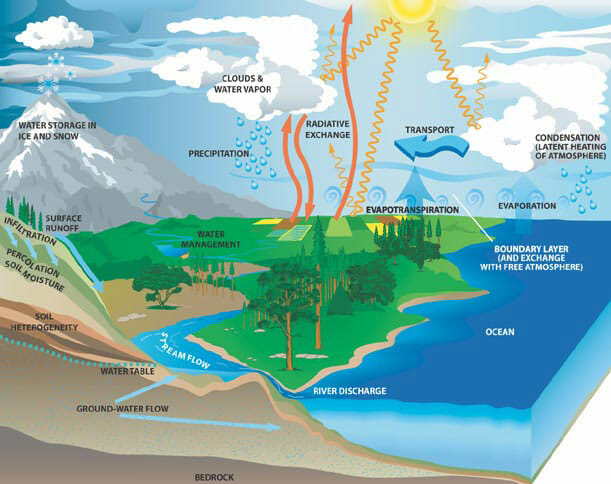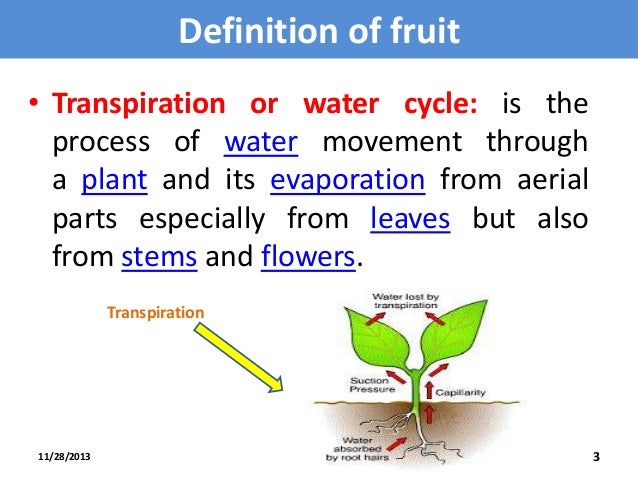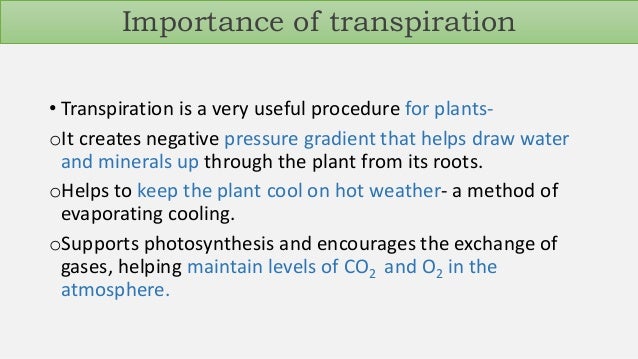Definition Of Transpiration Class 7
The question of stating the difference between diffusion and osmosis is a very common one. The remaining 97995 is lost by transpiration and guttation.
 Transpiration Definition Process Types Structure Of Stomata
Transpiration Definition Process Types Structure Of Stomata
The loss of water from plants as water vapour through the pores of their leaves is called transpiration.

Definition of transpiration class 7. Transpiration is a controlled and regulated phenomenon. Transpiration is the process of water movement through a plant and its evaporation from aerial parts such as leaves stems and flowers. Other Words from transpiration Example Sentences Learn More about transpiration.
Transpiration is very important for maintaining moisture conditions in the environment. Transpiration does not occur during the night because stomata are closed. The water is released out and into the Earths atmosphere.
Stomata help in exchange of gases which is intake of carbon dioxide and release of oxygen in the presence of water and sunlight by the process of photosynthesis. Transpiration is the process by which plants absorb water from the soil circulate it to all the branches and leaves to eventually release water vapor in the atmosphere through the pores of the leaves. As much as 10 percent of the moisture in the Earths atmosphere is from transpiration.
The process of transpiration puts a large amount of water vapour into the air. Plants prepare their food by photosynthesis. Transpiration - Transpiration is a term used for the release and evaporation of water from all plants including trees.
It is excess water and it leaves the plant through transpiration. Like all living organism plants also require an excretory system to discharge excess water from their body. An example of transpiration is when a plant absorbs water in its roots.
Generates suction pull which can pull water to great heights by xylem in very tall plants. It is an important process in plants that facilitates other processes and. To understand this we need to look closer at these two processes individually.
This process of elimination of excess water from the plant body is known as transpiration. Plants that are very tall and have hard and thick stem with branches in the upper parts of the stem are called trees. The environmental factors such as heat and wind are involved in facilitating the transpiration.
The act or process or an instance of transpiring especially. Transpiration refers to the movement of water vapor from the leaves to the atmosphere through the stoma whereas translocation refers to the movement of nutrients produced by the leaves throughout the plant body. The passage of watery vapor from a living body as of a plant through a membrane or pores.
Water is necessary for plants but only a small amount of water taken up by the roots is used for growth and metabolism. Transpiration is the evaporation of water from plants. Most of the water absorbed by the roots of a plant as much as 995 percentis not used for growth or metabolism.
Plants release water from the leaves in the form of vapour by the process of transpiration. It is generally the evaporation of water from the surface of the leaves. During the process of transpiration water molecules in the plant tissues are removed from the aerial parts of the plants.
Nearly 90 of this water exits the tree in the form of vapor through small pores called stomata on leaves. On the upper part of leaf there present number of small opening or pores called stomata. In other words we can say the major difference is that in osmosis the solvents move whereas in diffusion the molecules move.
Class 7 Biology Transportation in Animals and Plants. Some amount of water remain unused by the plant is released by stomata present on the leaves. Water vapour gets added to the air or atmosphere by the processes of evaporation and transpiration.
Transpiration also refers to the evaporation of water from the plant part. Thus transpiration can be defined as the process by which the plant body releases water in the form of vapors through its aerial parts. When the soil has high moisture content the water enters the roots because the water potential of the roots is less than that in the soil.
Trnsp-rshn Transpiration is the process where plants absorb water through the roots and then give off water vapor through pores in their leaves. The process of release of water in the form of water vapor is called transpiration. Leaf surfaces are dotted with pores called stomata and in most plants they are more.
 Transpiration 10th Science Transportation In Plants And Circulation In Animals In Tamil Youtube
Transpiration 10th Science Transportation In Plants And Circulation In Animals In Tamil Youtube
 Flower Transpiration Page 1 Line 17qq Com
Flower Transpiration Page 1 Line 17qq Com
6 L 5b 2 Photosynthesis Respiration Transpiration South Carolina 6th Grade Science
6 L 5b 2 Photosynthesis Respiration Transpiration South Carolina 6th Grade Science
 Transpiration In Plants Types Factors And Significance
Transpiration In Plants Types Factors And Significance
6 L 5b 2 Photosynthesis Respiration Transpiration South Carolina 6th Grade Science
6 L 5b 2 Photosynthesis Respiration Transpiration South Carolina 6th Grade Science
 Transpiration Definition Function And Examples Biology Dictionary
Transpiration Definition Function And Examples Biology Dictionary
 Class 7 Transpiration In Plants Science Ncert Cbse Board Home Revise Youtube
Class 7 Transpiration In Plants Science Ncert Cbse Board Home Revise Youtube
 Rozaini Othman Guru Cemerlang Biologi January 2010 Plant Science Plants Worksheets Water Plants
Rozaini Othman Guru Cemerlang Biologi January 2010 Plant Science Plants Worksheets Water Plants
 What Is Transpiration Pull An Overview Of Transpiration Pull In Plants
What Is Transpiration Pull An Overview Of Transpiration Pull In Plants
 Revision Notes For Science Chapter 7 Getting To Know Plants Class 6th Askiitians
Revision Notes For Science Chapter 7 Getting To Know Plants Class 6th Askiitians
Plant Life Cycle Phases Phase Three Stems And Transpiration
A Draw A Schematic Representation Of Movement Of Water In Plants During Transpiration And Explain It B Explain Transport Of Food And Other Substances Biology Topperlearning Com Cepl0in44
 Types Of Transpiration Http Www Aplustopper Com Transpiration Icse Solutions Class 10 Biology Plant Science Plants Worksheets Water Plants
Types Of Transpiration Http Www Aplustopper Com Transpiration Icse Solutions Class 10 Biology Plant Science Plants Worksheets Water Plants




Post a Comment for "Definition Of Transpiration Class 7"